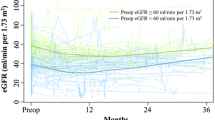Abstract
Objective
To describe renal functional outcomes after partial nephrectomy (PN) for a tumor in a solitary kidney using the estimated glomerular filtration rate eGFR (MDRD equation).
Patients and methods
A retrospective review of 103 cases of PN in a solitary kidney at Memorial Sloan-Kettering Cancer Center from December 1989 to July 2010 was conducted. The postoperative eGFR measurements were broken into three timeframes: 1–10 days after PN, 10 days–8 weeks after PN, and 4–12 months after PN. Several factors were analyzed for their impact on postoperative eGFR on univariate and multivariable analyses. To illustrate the change in eGFR after surgery over time, a univariate generalized estimating equation (GEE) model was constructed.
Results
Median preoperative eGFR was 47 ml/min/1.72 m2 (IQR 39, 58). Higher preoperative eGFR, younger age at the time of PN, less estimated blood loss during PN, increased time between PN and previous radical nephrectomy, and decreased arterial clamp (ischemia) time were all significantly associated with increased postoperative eGFR in the early postoperative period on multivariable analysis. Younger age and higher preoperative eGFR were the only variables significantly associated with increased postoperative eGFR at all three time points. From the GEE model, postoperative eGFR continues to rise after PN until it reaches a plateau approximately 1 month after PN without attaining preoperative levels.
Conclusion
PN for tumors in a solitary kidney is feasible and safe. In our model, non-modifiable factors predict the long-term postoperative eGFR: Young patients with healthy kidneys have superior renal functional results.



Similar content being viewed by others
References
Thompson RH, Kaag M, Vickers A et al (2009) Contemporary use of partial nephrectomy at a tertiary care center in the United States. J Urol 181:993
Zini L, Perrotte P, Capitanio U et al (2009) Radical versus partial nephrectomy: effect on overall and noncancer mortality. Cancer 115:1465
Huang WC, Levey AS, Serio AM et al (2006) Chronic kidney disease after nephrectomy in patients with renal cortical tumours: a retrospective cohort study. Lancet Oncol 7:735
Go AS, Chertow GM, Fan D et al (2004) Chronic kidney disease and the risks of death, cardiovascular events, and hospitalization. N Engl J Med 351:1296
Hollenbeck BK, Taub DA, Miller DC et al (2006) National utilization trends of partial nephrectomy for renal cell carcinoma: a case of underutilization? Urology 67:254
Saranchuk JW, Touijer AK, Hakimian P et al (2004) Partial nephrectomy for patients with a solitary kidney: the Memorial Sloan-Kettering experience. BJU Int 94:1323
Clavien PA, Sanabria JR, Strasberg SM (1992) Proposed classification of complications of surgery with examples of utility in cholecystectomy. Surgery 111(5):518–526
Levey AS, Bosch JP, Lewis JB et al (1999) A more accurate method to estimate glomerular filtration rate from serum creatinine: a new prediction equation. Modification of Diet in Renal Disease Study Group. Ann Intern Med 130:461
National Kidney Foundation et al (2002) K/DOQI clinical practice guidelines for chronic kidney disease: evaluation, classification, and stratification. Am J Kidney Dis 39:S1–S266
La Rochelle J, Shuch B, Riggs S et al (2009) Functional and oncological outcomes of partial nephrectomy of solitary kidneys. J Urol 181:2037
Becker F, Van Poppel H, Hakenberg OW et al (2009) Assessing the impact of ischaemia time during partial nephrectomy. Eur Urol 56:625
Thompson RH, Lane BR, Lohse CM et al (2010) Every minute counts when the renal hilum is clamped during partial nephrectomy. Eur Urol 58:340
Lane BR, Russo P, Uzzo RG et al (2011) Comparison of cold and warm ischemia during partial nephrectomy in 660 solitary kidneys reveals predominant role of nonmodifiable factors in determining ultimate renal function. J Urol 185:421
Ching CB, Lane BR, Campbell SC et al (2013) Five to 10-year followup of open partial nephrectomy in a solitary kidney. J Urol 190(2):470–474
Lindeman RD, Tobin J, Shock NW (1985) Longitudinal studies on the rate of decline in renal function with age. J Am Geriatr Soc 33:278
Ghavamian R, Cheville JC, Lohse CM et al (2002) Renal cell carcinoma in the solitary kidney: an analysis of complications and outcome after nephron sparing surgery. J Urol 168:454
Lee DJ, Hruby G, Benson MC et al (2011) Renal function and oncologic outcomes in nephron sparing surgery for renal masses in solitary kidneys. World J Urol 29:343
Simmons MN, Fergany AF, Campbell SC (2011) Effect of parenchymal volume preservation on kidney function after partial nephrectomy. J Urol 186:405
Acknowledgments
Supported by: The Sidney Kimmel Center for Prostate and Urologic Cancers.
Conflict of interest
The authors declare that they have no conflict of interests.
Ethical standard
This study has been approved by the appropriate ethics committee (IRB) and has therefore been performed in accordance with the ethical standards laid down in the 1964 Declaration of Helsinki.
Author information
Authors and Affiliations
Corresponding author
Rights and permissions
About this article
Cite this article
Ghoneim, T.P., Sjoberg, D.D., Lowrance, W. et al. Partial nephrectomy for renal tumors in solitary kidneys: postoperative renal function dynamics. World J Urol 33, 2023–2029 (2015). https://doi.org/10.1007/s00345-015-1581-9
Received:
Accepted:
Published:
Issue Date:
DOI: https://doi.org/10.1007/s00345-015-1581-9




